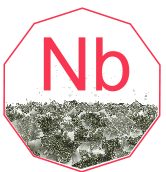Niobium

Niobium (Nb)
General Information
- Symbol: Nb
- Atomic Number: 41
- Atomic Weight: 92.90637 u
- Element Category: Transition metal
- Group: 5
- Period: 5
- Block: d-block
Physical Properties
- Appearance: Grayish, bluish-white metallic
- Density: 8.57 g/cm³
- Melting Point: 2477 °C (4491 °F)
- Boiling Point: 4744 °C (8571 °F)
- Phase at STP: Solid
- Electron Configuration: [Kr] 4d⁴ 5s¹
- Oxidation States: +5 (most common), +3
Chemical Properties
- Reactivity: Resistant to corrosion due to a protective oxide layer; reacts with acids and forms compounds with nonmetals.
- Compounds: Forms compounds such as niobium pentoxide (Nb₂O₅), niobium carbide (NbC), and niobium nitride (NbN).
Uses and Applications
- Steel Production: Used as an alloying element in high-strength low-alloy steels.
- Superconductors: Niobium-titanium and niobium-tin alloys are used in superconducting magnets.
- Electronics: Utilized in capacitors and other electronic components.
- Aerospace: Employed in jet engines and rocket subassemblies due to its high melting point and strength.
- Medical: Niobium alloys are used in medical implants and instruments because of their biocompatibility.
Occurrence and Extraction
- Natural Occurrence: Found primarily in the minerals columbite and pyrochlore.
- Extraction: Typically extracted from pyrochlore through a series of steps involving crushing, grinding, magnetic separation, and flotation, followed by chemical processing.
Isotopes
- Stable Isotope: Niobium-93
- Radioactive Isotopes: Several, including Niobium-94, Niobium-95
Safety and Handling
- Hazards: Generally considered to be of low toxicity, but niobium dust can be a respiratory hazard.
- Precautions: Handle niobium powder with care to avoid inhalation; use standard protective equipment in industrial settings.
History
- Discovery: Discovered by Charles Hatchett in 1801.
- Name Origin: Named after Niobe, the daughter of Tantalus in Greek mythology.
Additional Facts
- Crystal Structure: Body-centered cubic (bcc)
- Magnetic Properties: Diamagnetic
- Thermal Conductivity: Moderate, about 53.7 W/m·K
- Electrical Resistivity: About 152 nΩ·m at room temperature
Summary
Niobium is a transition metal known for its high melting point, strength, and corrosion resistance. It is used extensively in the steel industry, superconductors, electronics, aerospace, and medical applications. Found mainly in minerals like columbite and pyrochlore, niobium is extracted through chemical processes. Its stability and low toxicity make it valuable for various industrial and technological applications.
What is the atomic number of Niobium?
- 41
What is the symbol for Niobium?
- Nb
What is the atomic weight of Niobium?
- 92.90637 u
In which group of the periodic table is Niobium found?
- Group 5
What period is Niobium in?
- Period 5
What block does Niobium belong to?
- d-block
What is the melting point of Niobium?
- 2477 °C (4491 °F)
What is the boiling point of Niobium?
- 4744 °C (8571 °F)
What is the density of Niobium?
- 8.57 g/cm³
What is the electron configuration of Niobium?
- [Kr] 4d⁴ 5s¹
What are the common oxidation states of Niobium?
- +5, +3
What is the appearance of Niobium?
- Grayish, bluish-white metallic
Is Niobium reactive with acids?
- Yes, it reacts with acids
Name a compound of Niobium.
- Niobium pentoxide (Nb₂O₅)
What is a common use of Niobium in the steel industry?
- As an alloying element in high-strength low-alloy steels
How is Niobium used in superconductors?
- In niobium-titanium and niobium-tin alloys for superconducting magnets
What role does Niobium play in electronics?
- Used in capacitors and electronic components
How is Niobium used in aerospace?
- In jet engines and rocket subassemblies
Why is Niobium used in medical implants?
- Because of its biocompatibility
Name a mineral that contains Niobium.
- Columbite
How is Niobium extracted from pyrochlore?
- Through crushing, grinding, magnetic separation, flotation, and chemical processing
What is the most stable isotope of Niobium?
- Niobium-93
Name a radioactive isotope of Niobium.
- Niobium-94
What safety hazard is associated with Niobium dust?
- Respiratory hazard
Who discovered Niobium?
- Charles Hatchett
Where does the name Niobium come from?
- Named after Niobe, the daughter of Tantalus in Greek mythology
What is the crystal structure of Niobium?
- Body-centered cubic (bcc)
Is Niobium paramagnetic or diamagnetic?
- Diamagnetic
What is the thermal conductivity of Niobium?
- About 53.7 W/m·K
What is the electrical resistivity of Niobium at room temperature?
- About 152 nΩ·m
What is the primary oxidation state of Niobium?
- +5
Is Niobium found as a free element in nature?
- No, it is found in minerals
What is the common name of niobium pentoxide?
- Niobia
What is a major application of Niobium carbide (NbC)?
- Used in cutting tools
How does Niobium improve alloys?
- Increases strength and corrosion resistance
What is the boiling point of Niobium in Kelvin?
- 5017 K
What group does Niobium belong to in the periodic table?
- Transition metals
What is the natural abundance of Niobium-93?
- 100%
Can Niobium be used in high-temperature applications?
- Yes, due to its high melting point
What is the key property that makes Niobium valuable in superconductors?
- Its ability to form superconducting alloys.






